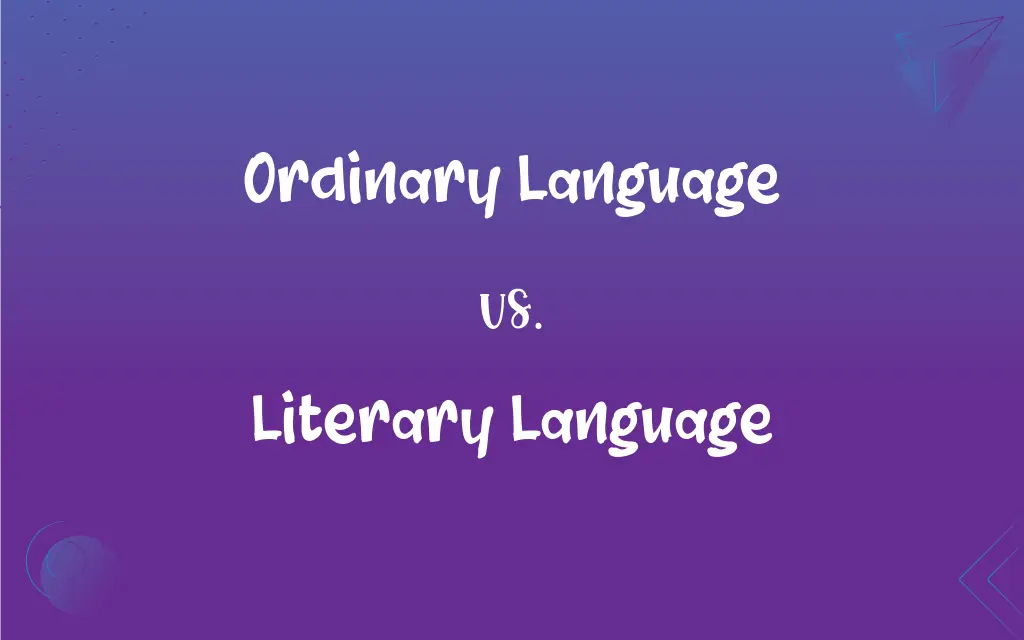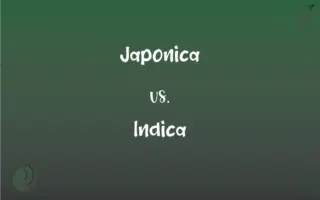Ordinary Language vs. Literary Language: What's the Difference?
Edited by Janet White || By Harlon Moss || Updated on October 7, 2023
Ordinary language refers to everyday communication used in common speech and writing. Literary language is a more stylized, expressive form used in literary works, often employing rich vocabulary and figurative speech.

Key Differences
The simplicity and practicality characterize ordinary language, aligning its structures and terminologies with daily interactions and communication. It prioritizes clarity and directness to facilitate effortless understanding and exchange of ideas. Ordinary language avoids complex syntactical structures and adheres to commonly accepted usage and expressions. Its vocabulary is familiar and accessible, ensuring straightforward communication among diverse individuals.
Literary language, on the other hand, encapsulates an elevated, often embellished form of expression. This expression medium leans heavily into stylistic and rhetorical devices such as metaphors, similes, and allegories to convey deeper meanings and elicit emotional responses. Literary language permits a deviation from conventional grammar and syntax rules, affording writers the liberty to explore creative, symbolic, and nuanced means of communication. It often entails an enriched vocabulary and a pronounced attention to aesthetic and rhythmic qualities of language.
In its essential form, ordinary language curtails misunderstandings by adopting a universally decipherable format, minimizing the potential for misinterpretations. It remains unadorned, seldom utilizing figurative language or ornate descriptors, thus maintaining a clear, unambiguous discourse. This manner of language seeks to uphold efficient, transparent, and functional communication, often eschewing elaborate or arcane vocabulary.
Contrarily, literary language thrives in its complexity and layered meanings, inviting readers to delve beneath the surface of mere words to unearth underlying themes, emotions, and images. It champions the evocative power of language, tapping into its potential to transport, transform, and transcend ordinary experiences and realities. This language form often embraces intricate syntactical constructions, poetic rhythms, and a discerningly chosen diction to cultivate a specific atmosphere or to articulate the ineffable.
With its roots firmly embedded in practicality, ordinary language fortifies the mechanics of daily communication, establishing a bridge among individuals in various contexts, such as in business, education, and casual interactions. It leans towards being direct and to the point, focusing more on the message conveyed than the manner of its presentation. The simplicity of ordinary language ensures that it remains accessible, inclusive, and democratic, permitting wide participation without necessitating specialized knowledge.
ADVERTISEMENT
Conversely, literary language offers a sanctuary for artistic exploration, enabling writers to weave tapestries of meaning through deliberate word choice, structured ambiguity, and innovative linguistic constructs. Literary language doesn't merely communicate; it paints, sings, and dances, sculpting emotions, thoughts, and images into a tangible form that can be shared, interpreted, and appreciated in myriad ways. It becomes a playground for imagination and a vessel for voyaging beyond the mundane, immersing the reader into worlds crafted through words.
Comparison Chart
Purpose
Facilitates clear communication.
Encourages artistic expression.
Vocabulary
Common and practical.
Rich and elaborate.
Syntactical Complexity
Simple and straightforward.
Complex and stylized.
Figurative Use
Limited or none.
Extensive and intrinsic.
ADVERTISEMENT
Accessibility
Universal and widely comprehensible.
May require interpretive engagement.
Ordinary Language and Literary Language Definitions
Ordinary Language
Utilitarian Communication.
Please pass the salt.
Literary Language
Rich Imagery.
Golden sunsets kissed the tranquil sea, as day caressed night in a tender embrace.
Ordinary Language
Direct Interaction.
I need help with my computer.
Literary Language
Elevated Diction.
Amidst the abyss of eternity, souls dance to the serenade of cosmic silence.
Ordinary Language
Common Vernacular.
It’s raining cats and dogs.
Literary Language
Artistic Expression.
The azure heavens painted the horizon with whispers of forgotten dreams.
Ordinary Language
Colloquial Speech.
Wanna grab a coffee later?
Literary Language
Stylized Narrative.
Winds whispered secrets to ancient oaks, entwining tales of epochs gone by.
Ordinary Language
Simple Expression.
I'm very tired.
Literary Language
Symbolic Connotation.
In the caverns of despair, hope sung its silent melody.
FAQs
Can ordinary language be used in formal writing?
Yes, ordinary language can be used in formal contexts, prioritizing clarity and conciseness, though maintaining formality in terms of politeness and respect.
Is literary language restricted to poetry and novels?
No, literary language can be utilized across various mediums, including speeches, essays, and more, wherever artistic expression is desired.
Can ordinary language be effective in storytelling?
Yes, ordinary language can tell stories effectively, especially when clarity and relatability are prioritized.
Is literary language inherently better than ordinary language?
No, neither is inherently better; they serve different purposes, with literary language focusing on artistic expression and ordinary language prioritizing clear communication.
Can ordinary language convey complex concepts and ideas?
Yes, it can convey complex ideas, often aiming to do so in a manner that is straightforward and easily comprehensible.
Does literary language always adhere to grammatical rules?
Literary language often allows flexibility with grammatical rules to enhance stylistic and artistic expression.
Does literary language change with time and cultural contexts?
Yes, it evolves, reflecting shifts in cultural, social, and artistic norms, and may vary distinctly across different historical and cultural contexts.
Can literary language be found in modern mediums like films and TV shows?
Absolutely, through dialogues, narrations, and even visual metaphors, literary language can be utilized in films and TV shows to enrich the storytelling and thematic expression.
Why might an author choose to use literary language?
Authors might use literary language to explore and express deeper meanings, emotions, and aesthetics, providing readers with a rich and immersive experience.
Can a text combine both ordinary and literary language?
Absolutely, many texts, especially literary works, might blend both, using ordinary language for dialogue or clarity and literary language for descriptive and symbolic purposes.
Is understanding literary language necessary for appreciating literature?
While one can appreciate literature without fully diving into the depths of literary language, a deeper understanding can enhance appreciation by unveiling layered meanings and artistic nuances.
Can literary language be used in non-fiction writing?
Yes, non-fiction works, such as memoirs or essays, might employ literary language to enhance the expressive and evocative quality of the text.
Can a mastery of ordinary language enhance literary expression?
Certainly, a strong grasp of ordinary language can provide a solid foundation upon which literary expression can be built, explored, and nuanced.
How does one transition from using ordinary language to exploring literary language in writing?
Embracing literary language might involve exploring varied vocabulary, engaging with different literary works, understanding the use of figurative speech, and experimenting with stylistic and rhetorical devices in writing.
Why is it vital to preserve the nuances of literary language in translation?
Preserving nuances is essential to maintain the original’s aesthetic, emotional, and symbolic richness, ensuring that the translated work echoes the original's depth and expressive quality.
Is it important to teach ordinary language in educational settings?
Yes, since ordinary language forms the basis of daily communication, it is crucial in educational settings to enable students to express themselves clearly and comprehend others effectively.
Is ordinary language devoid of beauty or emotional expression?
Not at all. Ordinary language can beautifully and potently convey emotions and ideas; its beauty often lies in its clarity, relatability, and directness.
Does ordinary language utilize metaphors and similes?
While it can, ordinary language typically employs fewer metaphors and similes, prioritizing direct communication.
Are there rules governing the use of ordinary language?
While ordinary language adheres to commonly accepted grammar and usage, it can be flexible and adapt to regional vernaculars and colloquialisms.
Do all cultures have a form of literary language?
Most cultures develop a form of literary language, often shaped by their unique social, historical, and cultural contexts and expressed through diverse literary traditions.
About Author
Written by
Harlon MossHarlon is a seasoned quality moderator and accomplished content writer for Difference Wiki. An alumnus of the prestigious University of California, he earned his degree in Computer Science. Leveraging his academic background, Harlon brings a meticulous and informed perspective to his work, ensuring content accuracy and excellence.
Edited by
Janet WhiteJanet White has been an esteemed writer and blogger for Difference Wiki. Holding a Master's degree in Science and Medical Journalism from the prestigious Boston University, she has consistently demonstrated her expertise and passion for her field. When she's not immersed in her work, Janet relishes her time exercising, delving into a good book, and cherishing moments with friends and family.































































